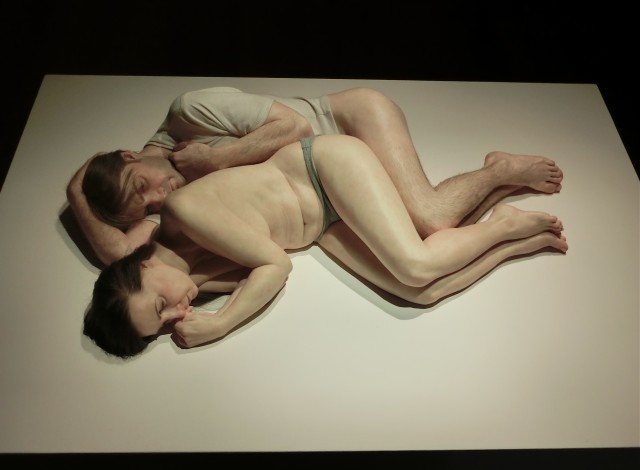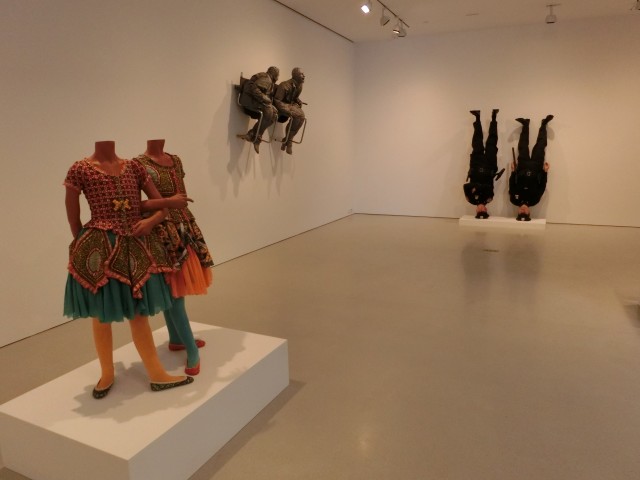
Ron Mueck’s ultra-realistic “Spooning Couple” is part of “A Secret Affair” at FLAG (photo by twi-ny/mdr)
The FLAG Art Foundation
545 West 25th St. between Ninth & Tenth Aves.
Wednesday through Saturday through May 16, free, 11:00 am – 5:00 pm
212-206-0220
flagartfoundation.org
The name of the current exhibit at the FLAG Art Foundation, “A Secret Affair,” conjures thoughts of clandestine coupling. Indeed, the show, which continues through May 16, features works that explore, both as physical objects and conceptual ideas, the notion of pairs, of the double, built around what senior curator Heather Pesanti refers to in her catalog essay, “The Subversive Body,” as “meditations on the most primal and basic emotional need in life: that of human connection.” Spread across two floors of the Chelsea gallery, “A Secret Affair: Selections from the Fuhrman Family Collection” consists primarily of sculptures, along with several C-prints, that are either partnered within themselves or with another piece, by the same or a different artist. The subjects in Ron Mueck’s ultra-realistic but miniature “Two Women,” a pair of older women in heavy coats standing together but looking away, might recall fondly, or jealously, the nearby “Spooning Couple,” in which a partially naked man and woman spoon each other on a hard surface representing a bed. Meanwhile, not far away, Subodh Gupta offers a counterpart, “Spooning,” a sculpture of two large-scale stainless-steel spoons one on top of the other. In Juan Muñoz’s “Two Laughing at Each Other,” a pair of men sit in chairs halfway up a wall, not far from Maurizio Cattelan’s “Frank and Jamie,” two life-size wax figures of New York City policemen standing on their heads. In Louise Bourgeois’s “Couple,” a naked and armless man and woman, in pink fabric, face each other in a vitrine, belly to belly, while Yinka Shonibare’s “Girl Girl Ballerina” depicts a pair of headless female figures wearing colorfully patterned fabrics, hiding guns behind their backs. Gillian Wearing’s lifelike “Olia,” a topless model in jeans, finds its counterpoint in Marc Quinn’s “Sphinx (Fortuna),” a painted bronze sculpture of Kate Moss in a seemingly impossible pose. And Thomas Schütte’s patinated bronze and steel busts, “Wicht (4)” and “Wicht (7),” are on plinths next to each other, a pair of mysterious, already fading figures.
Even the single pieces in the exhibition, curated by Louis Grachos, deal with pairs. “I decided that the exhibition would focus on interrelated themes concerning the body and the figure, as well as coupling and conversation,” Grachos explains in his catalog foreword. In Charles Ray’s “Light from the Left,” the artist offers flowers to a woman, trying to make a connection. In Katharana Fritsch’s “Oktopus,” an orange cephalopod mollusc holds aloft a faceless human figure in black in one of its tentacles. Felix Gonzalez-Torres’s 1995 untitled work comprises two silver-plated brass rings flat against a wall, touching each other, evoking the magician’s trick as well as the prize one can win on a merry-go-round. Anish Kapoor’s “Blood Solid,” a red balloon-like sculpture that resembles a huge drop of blood, invites viewers to see their reflection in it, their own double. There are also works by Matthew Barney, Kiki Smith, Robert Gober, Jim Lambie, David Hammons, and Jim Hodges that provide yet more insight on the theme. In conjunction with Frieze week’s Chelsea Night, Hodges, whose “picturing: my heart” dual skulls and “First Light (Beginning of the End)” mirrored glass pieces are on display at FLAG, will be at the gallery on May 16 at 5:00 for a special closing conversation with FLAG founder Glenn Fuhrman, who owns the collection with his wife, Amanda.
